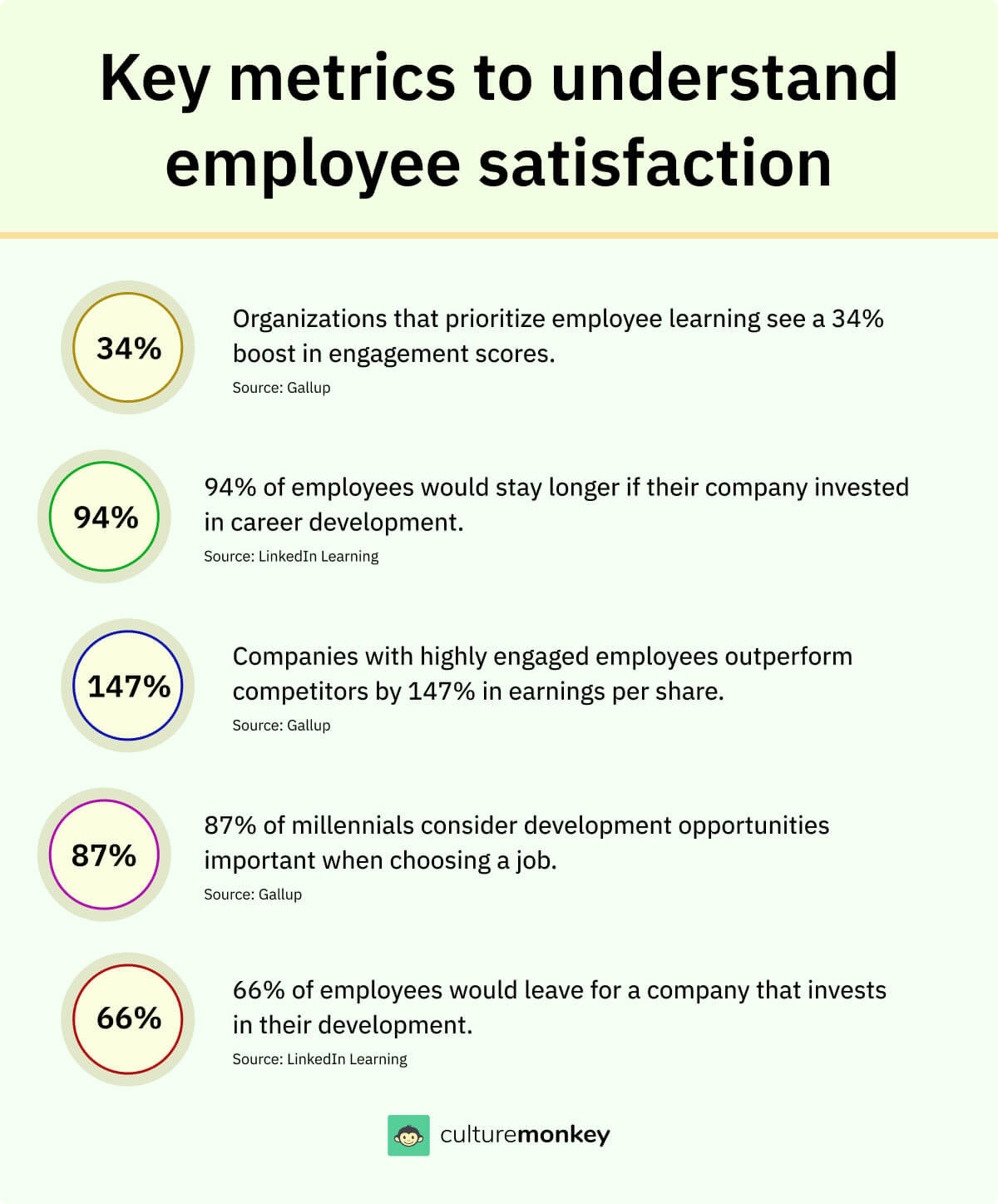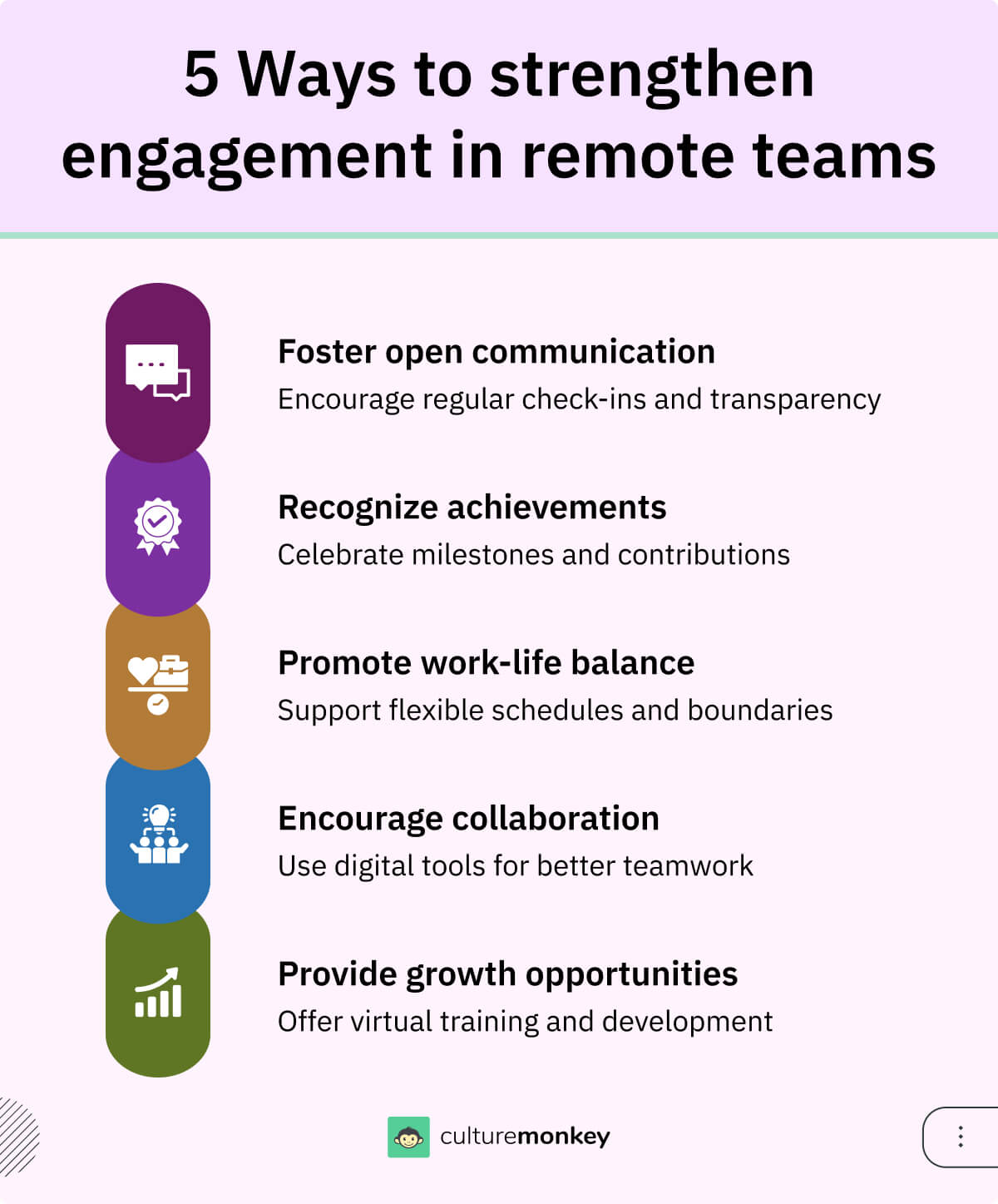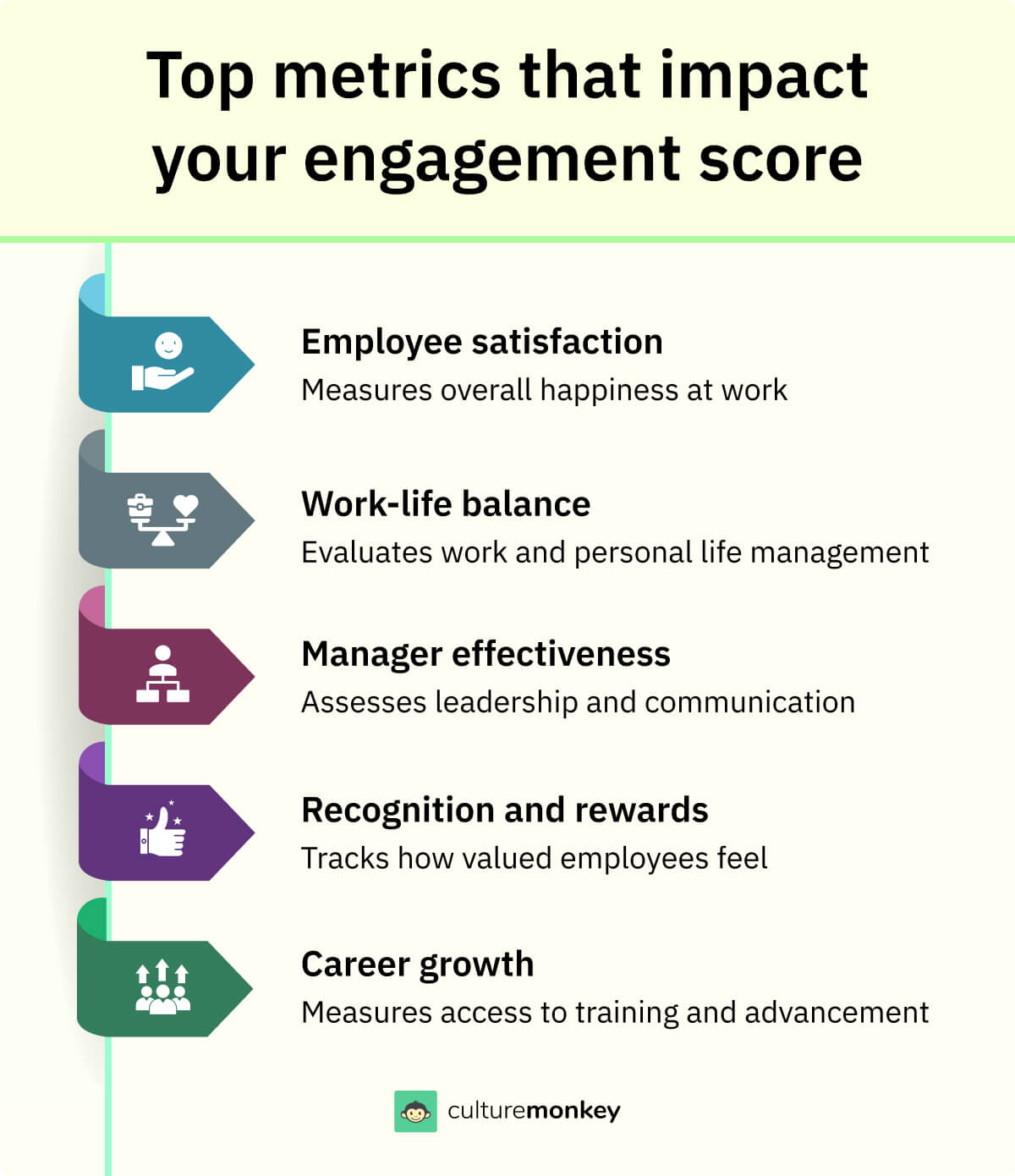Employee satisfaction score: Metrics, analysis, and actionable insights for HR leaders in 2026

Remember the excitement of watching a sequel to your favorite movie only to walk out thinking, “Something was missing”? That’s what happens when organizations look at their employee engagement scores and assume a high number automatically means strong employee satisfaction.
When your culture sets expectations, the sequel of your reality decides whether people stay invested. A truly healthy employee satisfaction rate is built on emotional continuity and genuine connection. The real success of your employee engagement and satisfaction strategy depends on whether what people feel matches what they were promised. Otherwise, even loyal fans start skipping the trailer.
Read on to see how improving your employee satisfaction rate can turn every culture sequel into a long-running hit.
- Employee satisfaction rate reflects how content and motivated employees feel about their work, leadership, and environment—shaping overall engagement and retention.
- Measuring satisfaction through surveys, eNPS, and feedback loops helps uncover hidden issues, boost productivity, and strengthen culture.
- Accurate measurement blends quantitative data with qualitative insights—balancing survey design, analysis, and actionable planning.
- High satisfaction scores don’t always mean equality or engagement; addressing disparities, context, and follow-through is key.
- CultureMonkey’s employee satisfaction survey unifies real-time analytics, AI-driven insights, and lifecycle feedback to boost engagement, trust, and retention.
Why is employee engagement important?

Think of engagement like Wi-Fi; you only notice it when it drops. When it’s strong, everything connects and flows effortlessly. Here’s what your employee engagement score is really trying to tell you: it’s not just a metric; it’s the pulse of how deeply people feel valued and connected at work.
Engaged employees feel valued, communicate openly, and create better customer experiences, making engagement the emotional backbone of a thriving, loyal, and high-performing workplace culture.
- Higher productivity: A high employee engagement score translates to ownership, drive, and better output across teams.
- Greater job satisfaction: When employee satisfaction scores rise, fulfillment follows thus helping teams feel aligned and proud of their work.
- Stronger retention: A consistent staff engagement score helps retain top talent by connecting purpose to performance.
- Deeper loyalty: Employees who find meaning in their roles become long-term advocates, lifting both morale and brand equity.
- Better collaboration: Engaged teams communicate openly and build trust across departments, driving synergy.
- More innovation: High employee engagement scores often predict creative problem-solving and new ideas that push growth.
- Happier customers: A solid employee satisfaction rate leads to more authentic, high-quality customer experiences.
- Healthier culture: Continuous employee satisfaction measurement fosters transparency, fairness, and a culture people want to join and stay in.
When engagement rises, the results aren’t just numbers on a dashboard; they’re reflections of real worker satisfaction that shape how teams show up each day.
Create caring and robust connections between every employee and their work, customers, leaders, managers, and the organization to achieve results that matter to everyone in this sentence.
Why should you measure employee engagement in the first place?

Imagine running a marathon blindfolded. You might move fast, but not necessarily in the right direction. Measuring engagement works the same way. Your employee engagement index and employee satisfaction rate reveal where motivation flows and where friction hides.
The insights inside every employee engagement report are what turn data into direction.
- Identify strengths and areas for improvement: Provides insights into organizational strengths and weaknesses, helping focus efforts on areas that need attention to foster an engaging workplace.
- Enhance employee satisfaction score and retention: Gauges satisfaction levels, identifies drivers of loyalty, and enables proactive steps to improve engagement, retention, and reduce turnover costs.
- Drive performance and productivity: Correlates engagement levels with performance metrics, helping develop strategies to improve productivity through stronger engagement.
- Enhance decision-making and strategy development: Offers data-driven insights to evaluate policies and align strategies with employee needs for better organizational outcomes.
- Foster a culture of feedback and continuous improvement: Encourages regular feedback, demonstrating that employee opinions matter and fostering trust, transparency, and positive change.
- Support employee development and well-being: Identifies areas requiring additional support, promoting employee growth, satisfaction, career progression, and overall well-being.
You can’t improve what you can’t quantify. The key is to capture those early shifts in workplace satisfaction before they turn into deeper cultural cracks.
What are the 3 key aspects of measuring employee engagement?

Imagine tuning a guitar; you don’t just twist one string and call it harmony. Every string needs balance for the sound to work. Here’s where most HR teams misread their employee engagement survey results: measurement isn’t about asking questions, it’s about creating balance between data, design, and decisions that keep your culture in tune.
Survey design and administration
Design surveys with clear, concise questions addressing job satisfaction, motivation, and commitment. Ensure anonymity to promote honest feedback. Administer surveys regularly to capture updated insights and track engagement trends.
Data analysis and interpretation
Analyze survey data to identify trends, strengths, and improvement areas. Use statistical methods like correlation and factor analysis to uncover relationships. Proper interpretation leads to meaningful, actionable insights.
Action planning and implementation
Develop targeted action plans based on survey findings, with clear goals and responsibilities. Communicate plans to employees, involve them in initiatives, and monitor progress to drive engagement improvements.
Metrics tell a story but only if they connect to what employees truly feel. Let’s decode how engagement data and job satisfaction statistics intersect.
What is the engagement score?

The engagement score is a numerical representation of how emotionally committed and motivated employees are within an organization. Typically derived from survey responses, the employee engagement score helps HR teams track workforce morale, productivity, and satisfaction using structured data and feedback. The staff engagement score is calculated based on responses to survey questions tied to workplace sentiment—covering areas such as job satisfaction, belonging, motivation, and purpose.
These are often rated using a Likert scale, and the responses are aggregated to generate overall engagement scores. Understanding the engagement score meaning gives companies a reliable baseline for progress.
While knowing how to calculate employee engagement score is important, it’s only one part of the equation. To fully measure employee satisfaction, companies should pair employee engagement score calculation with qualitative feedback, open-text responses, and behavior-based insights.
To improve employee happiness, organizations must also rely on employee satisfaction metrics, explore various employee satisfaction measurement tools, and consistently invest in measuring employee satisfaction through multiple lenses. These steps help leaders better understand and measure employee satisfaction while making data-backed culture improvements.
An engagement score shows commitment, but satisfaction deepens it. The next step is learning how work satisfaction drives long-term engagement.
Source: (Novoresume)
What are the benefits of measuring employee satisfaction?
Think of checking employee satisfaction ratings like checking a plant’s soil moisture—it tells you when things look fine on the surface but are drying underneath. Your employee satisfaction rate and employee engagement report act the same way by revealing hidden patterns. The employee engagement rate formula then turns those into insights leaders can act on.
- Uncover hidden issues before they escalate: Regular monitoring of employee satisfaction scores and employee satisfaction ratings helps HR leaders detect early signs of disengagement, workplace dissatisfaction, or communication gaps—allowing for proactive solutions.
- Improve engagement survey scores over time: By identifying low-performing areas through the employee engagement scorecard, organizations can take focused action to improve engagement survey scores and boost team morale.
- Support strategic people decisions: Analyzing results from a team engagement score or a broader employee engagement index allows leaders to align talent strategies with actual workforce sentiment.
- Build a data-driven culture of trust: When employees see their feedback reflected in changes, it strengthens trust and encourages open communication. Using tools like an employee engagement scoring matrix or tracking the level of engagement scale supports transparency.
- Optimize performance and productivity: Satisfied employees are more likely to be productive. Insights from employee satisfaction scores and a clear understanding of what is a good engagement score can directly impact output quality.
- Track progress with measurable insights: Understanding what is engagement score and aligning it with the employee engagement score meaning gives organizations a clear path to measure impact and adjust strategies for continuous improvement.
Every metric reveals employee engagement score meaning and pain points. But to act on insights, you need visibility into employee satisfaction data, where numbers meet emotions.
What are the common challenges in measuring employee satisfaction metrics?
Most leaders assume how to calculate employee engagement score is about data but it’s really about direction. Here’s the twist: your employee engagement score calculation can look promising while your employee satisfaction rate quietly declines. That’s the tension between what’s measured and what’s actually felt—numbers versus narratives, metrics versus meaning.
Challenges include unclear engagement score meaning, inconsistent calculation methods, over-reliance on numbers without context, low survey participation, one-size-fits-all templates, and weak follow-through—making insights unreliable and hard to translate into targeted actions that genuinely improve satisfaction.
- Lack of clarity in engagement score meaning: Without a standardized understanding of what an engagement score means, results can be misinterpreted or fail to drive action, limiting their strategic value.
- Inconsistent employee engagement score calculation methods: Many organizations struggle with how to calculate employee engagement score effectively, leading to varying employee engagement scores that may not reflect true sentiment.
- Over-reliance on numerical data without context: Focusing solely on the staff engagement score or engagement scores can overlook the “why” behind the numbers, missing valuable qualitative feedback and emotional nuances that impact employee happiness.
- Low participation rates in surveys: When participation is low, the accuracy of the employee engagement score becomes questionable. This challenge can skew insights and reduce the reliability of the data collected.
- One-size-fits-all survey models: Using generic survey templates may not align with your team’s culture, affecting how authentic and relevant the responses are—especially when aiming for accurate staff engagement score insights.
- Difficulty in converting data into action: Even after collecting results, teams often lack the frameworks to turn feedback into change. Without proper analysis and follow-up, engagement scores remain static and fail to influence improvement.
Challenges aside, data without direction falls flat. The next move is to explore engagement tools that turn employees satisfaction into measurable outcomes.
What is the best way to measure employee engagement accurately?

Picture this: your HR team runs a new survey, excitement fills the room, and dashboards flash colorful results. But here's what is a good employee engagement rate trying to tell you—it’s not about collecting the average employee engagement score; it’s about connecting meaning.
The best measurement blends method, emotion, and the right employee satisfaction score formula.
- Employee engagement surveys: Use carefully designed surveys to assess areas like job satisfaction, communication, and work-life balance. Administer electronically or on paper, ensuring anonymity for honest feedback.
- Pulse surveys: Conduct shorter, focused surveys monthly or quarterly to gather real-time feedback. Use them to track changes in engagement, monitor specific initiatives, and identify emerging trends.
- Focus groups and interviews: Facilitate group discussions or one-on-one interviews to gather detailed, qualitative insights. These sessions allow employees to share concerns, suggestions, and ideas for improvement.
- Observation and feedback from managers: Managers can observe team behaviors, attitudes, and enthusiasm during daily interactions. Their feedback offers valuable qualitative insights into engagement levels and team dynamics.
- Performance metrics and business indicators: Analyze metrics like productivity, absenteeism, turnover, and customer satisfaction to uncover correlations with engagement. These indicators provide indirect yet actionable insights.
Measurement is a mirror but what reflects back must align with goals. That’s where an employee engagement score kpi makes progress tangible.
What metrics best measure employee engagement effectively?

In data-driven workplaces, here’s the part of your employee engagement report most leaders overlook: the employee engagement scoring matrix themselves reveal not just performance, but sentiment. Measuring your employee engagement index formula or employee satisfaction rate helps you connect feelings with outcomes that shape long-term culture.
- Response rates: Tracks the percentage of employees participating in surveys. High response rates indicate interest and engagement. Ensures data is reliable and representative.
- Retention rates: Measures the percentage of employees staying with the organization. High retention reflects effective engagement and a positive workplace experience.
- Absenteeism and sick leave: Monitors employee absence frequency and duration. Lower absenteeism suggests higher engagement, while spikes may indicate stress or dissatisfaction.
- Performance metrics: Tracks productivity, quality, and goal achievement. Engaged employees typically perform better, linking engagement to business outcomes.
- Employee net promoter score (eNPS): eNPS Measures how likely employees are to recommend the organization. Higher scores indicate stronger engagement and satisfaction.
- Employee feedback and suggestions: Gathers qualitative insights through feedback channels. Helps uncover engagement drivers and improvement areas.
- Peer recognition and awards: Tracks recognition frequency among employees. Higher recognition indicates engagement and a supportive workplace culture.
Metrics help analyzing employee engagement survey results, but to visualize it fully, you need an employee engagement graph that brings trends to life.

Ask the right questions,
get better results
Discover 20 essential questions to measure, understand, and enhance your employee engagement score.
Download NowHow to calculate engagement score?

Ever tried baking without measuring ingredients? You might get something edible but not consistent. Here’s the simplest way to calculate your employee engagement score formula: treat every metric as an ingredient, measured precisely and adjusted with context. Together, they form the recipe your employee engagement report uses to reveal true satisfaction and motivation trends.
- Determine engagement factors: Start by identifying the key factors that contribute to employee engagement within your organization. These factors may include job satisfaction, organizational commitment, communication effectiveness, growth opportunities, and work-life balance.
- Design survey questions: Develop a set of survey questions that assess each engagement factor. Use a Likert scale or a similar rating system to capture employees' responses to each question. Ensure that the questions are clear and concise, and cover the intended engagement factors.
- Administer the survey: Distribute the engagement survey to all employees within the organization. It can be conducted electronically, through an online survey platform, or on paper. Ensure that the survey is anonymous and that employees feel comfortable providing honest feedback.
- Score the survey responses: Assign numerical values to the responses based on the chosen rating scale. For example, if using a Likert scale ranging from 1 to 5, assign a value of 1 for "Strongly Disagree" and 5 for "Strongly Agree."
- Weight the engagement factors: If certain engagement factors are considered more important than others, assign appropriate weights to reflect their relative significance. Multiply the average score of each engagement factor by its corresponding weight to give it more or less influence on the overall engagement score.
- Calculate the engagement score: To calculate the overall engagement score, sum up the weighted or unweighted average scores of all engagement factors. This provides a single numerical value representing the level of employee engagement within the organization. The score can be presented as a percentage, a rating on a scale (e.g., 1 to 10), or any other format that suits your organization's needs.
- Analyze and interpret the results: Once the engagement score is calculated, analyze the results to identify areas of strength and areas for improvement. Compare the scores across different engagement factors and demographic groups to gain insights into variations in engagement levels. Use the findings to develop action plans and strategies that address specific engagement challenges and capitalize on areas of strength.
Calculations reveal insights, but the real shift happens after change. Let’s explore how engaged teams reflect through staff engagement survey results over time.

How can you improve your employee engagement score effectively?
Most leaders chase higher scores but the goal isn’t a perfect number. Your employee engagement scorecard, employee engagement benchmark scores, and team engagement metrics reveal where energy flows or fades. Working on engagement survey score improvement gradually lifts both employee satisfaction rate and overall engagement index performance.
- Encourage cross-departmental collaboration: Break down silos by promoting cross-departmental collaboration. Organize projects or brainstorming sessions that require input from multiple teams to foster teamwork, innovation, and a sense of shared purpose.
- Empower employees with autonomy: Grant employees more autonomy in decision-making and daily tasks. Providing opportunities for ownership increases accountability, satisfaction, and overall engagement. Trusting employees to take the lead boosts morale and confidence.
- Personalized career development plans: Go beyond generic training programs by offering personalized career development plans tailored to individual employee goals. This shows a genuine interest in their growth, strengthening engagement and loyalty.
- Offer non-monetary rewards: Recognition doesn’t always have to involve monetary incentives. Celebrate achievements with personalized rewards, such as extra time off, mentorship opportunities, or access to special projects, to keep employees motivated.
- Enhance workplace design: A well-designed workspace improves tools to measure employee satisfaction measurement tools and engagement. Consider adding collaborative zones, quiet areas for focused work, or wellness spaces that contribute to a positive work environment.
- Promote community involvement: Encourage employees to participate in community service or charity work supported by the organization. Connecting employees with meaningful causes fosters a deeper sense of purpose and engagement.
- Use real-time feedback tools: Implement engagement platforms that provide instant feedback opportunities and pulse surveys. Quick feedback loops offer insights to improve work experiences and track changes via the employee engagement score.
- Facilitate meaningful manager check-ins: Encourage consistent one-on-one conversations between employees and managers. These check-ins should focus on development, well-being, and listening—key to maintaining a healthy employee engagement scorecard.
- Celebrate team wins regularly: Regularly acknowledge milestones and team achievements through shout-outs, team lunches, or recognition ceremonies. This cultivates positivity, boosts morale, and reinforces a shared vision.
Improvement means movement not just in numbers, but emotions. The next section explores what jobs with highest satisfaction reveal about engagement success stories.
What are some examples of employee engagement scores?

Think of your employee engagement score like a map—it shows where you stand, not where you’ll end up. Comparing employee engagement survey results, benchmark scores, and staff engagement index data helps reveal how each team performs. Together, these engagement score examples explain your organization’s true satisfaction story.
- 1 to 5 scale: On a scale where 1 represents low engagement and 5 represents high engagement, a score above 4 typically indicates a highly engaged workforce.
- Percentage-based scoring: In systems where engagement is scored as a percentage, a score above 80% is generally considered a sign of strong employee engagement.
- eNPS (Employee Net Promoter Score): For eNPS, which ranges from -100 to +100, a score of +50 or higher is often seen as excellent, reflecting high levels of engagement and satisfaction.
- Context-specific scoring: A manufacturing company may consider a score of 75% highly engaged, while a tech company with higher industry benchmarks might target 85% or more.
- Departmental or team scores: Scores above 4.5 on a 1 to 5 scale in key teams or departments often suggest high engagement in those specific groups.
- Pulse survey scores: Monthly pulse survey metrics showing consistent scores above 8 out of 10 signal positive trends in employee engagement over time.
Examples show what’s working, but longevity tells the truth. Let’s discuss how careers with highest satisfaction maintain engagement over years, not quarters.
What is a good employee engagement score?

Imagine checking your fitness progress. You wouldn’t judge one workout, you’d watch the trend. A good employee engagement index score or employee engagement rate formula works the same way. The key is reading your employee engagement report over time, pairing data with employee satisfaction survey results for balanced insight.
- Internal comparison: An effective way to assess the level of engagement scale score is by comparing it to previous scores within the organization. Tracking engagement trends over time allows organizations to gauge progress and improvement.
- External comparison: Benchmarking against industry standards or similar organizations can provide valuable insights. Industry-specific surveys or reports may provide average engagement scores, allowing for a comparison to determine how the organization fares about its peers.
- Contextual factors: Employee engagement is influenced by various factors such as organizational culture, work environment, and employee demographics. Consider the specific circumstances and challenges within the organization when evaluating the engagement score. For instance, if the organization recently underwent significant changes or faced operational challenges, the engagement score may be lower temporarily.
- Qualitative feedback: Analyzing open-ended survey responses, conducting focus groups, or gathering feedback through other channels can offer deeper insights into the underlying factors driving engagement or areas for improvement.
- Employee perception: Assess how employees perceive the work environment, their level of job satisfaction metrics, and their overall commitment to the organization. Consider conducting additional surveys or feedback mechanisms to capture employee sentiment and validate the engagement score.
Good scores are only half the story — because what happens when the numbers dip? Let’s explore early indicators of workplace dissatisfaction.
Which employee satisfaction measurement channels should you use?
Picture an organization trying to understand its people by reading only quarterly reports—it misses the story between the lines. To capture authentic satisfaction, blend employee satisfaction data, survey results, and employee engagement rate insights. Measuring across multiple channels gives leaders a real-time view of work satisfaction, sentiment, and trends in the employee satisfaction index.
Use multiple channels: 360-degree feedback, employee journey mapping, AI sentiment analysis, town halls, wellness feedback, and stay interviews.
Blending these signals with engagement metrics provides visibility into satisfaction, trends, and improvement opportunities across employee lifecycle.
- 360-degree feedback programs: This method offers a holistic perspective on employee satisfaction scores and employee satisfaction ratings by gathering input from peers, managers, and direct reports. It enhances trust and transparency, providing valuable input for your employee engagement scorecard.
- Employee journey mapping: Mapping satisfaction throughout the employee lifecycle—onboarding, growth, and exit—helps pinpoint critical touchpoints. Comparing trends using a level of engagement scale or team engagement score reveals where to enhance experiences.
- Sentiment analysis tools: AI-powered platforms analyze communication data to gauge satisfaction and real-time sentiment. These tools can uncover trends aligned with the employee engagement scoring matrix, contributing to actionable insights.
- Town hall meetings: These meetings foster open dialogue and offer opportunities to improve engagement survey scores through live feedback, reinforcing clarity around what is a good engagement score.
- Wellness program feedback: Participation and reactions to wellness programs can reflect on employee engagement score meaning, offering signals for satisfaction and well-being across teams.
- Stay interviews: One-on-one stay interviews provide valuable insights from top talent before issues arise. Understanding what is engagement score through such proactive efforts helps maintain commitment and reduce attrition.
Each measurement channel gives a signal, but to know if those signals last, we’ll look at how being work satisfied influences engagement over time.
What are the indicators of a bad employee engagement score?

When employee engagement indicators, survey results, and employee satisfaction statistics start dipping, they reveal early signs of workplace dissatisfaction. Tracking these patterns through employee satisfaction data and the employee engagement rate formula can expose deeper morale issues before they spread.
- High turnover rates: When employees are disengaged, they are more likely to seek opportunities elsewhere, leading to increased turnover. High turnover rates can disrupt productivity, increase recruitment and training costs, and impact team morale.
- Low productivity: Disengaged employees may exhibit reduced motivation, lack of focus, or decreased effort in their work, resulting in lower overall productivity levels. Consistently low productivity can have negative effects on business outcomes and hinder organizational growth.
- Increased absenteeism and sick leave: Higher rates of absenteeism can indicate disengagement and lack of commitment to work. Excessive absenteeism can impact overall organizational performance.
- Lack of initiative and innovation: Disengaged employees may be less likely to contribute new ideas, offer suggestions for improvement, or take on additional responsibilities.
- Decreased customer satisfaction: Disengaged employees may provide subpar customer service or fail to meet customer expectations, leading to decreased customer satisfaction. Unsatisfied customers can have a detrimental impact on the organization's reputation, customer retention, and bottom line.
- Poor communication and collaboration: A lack of effective communication and collaboration among employees can indicate low engagement. This can hinder information flow, decision-making processes, and overall organizational effectiveness.
- Low employee morale and negative workplace atmosphere: Disengaged employees often experience lower morale, leading to a negative workplace atmosphere. A negative workplace environment can further contribute to disengagement and hinder employee well-being.
When engagement falters, satisfaction often follows. Let’s explore whether being satisfied with job really translates into sustainable engagement.
What if the rise in employee satisfaction rates isn’t truly equal for everyone?
It’s a valid question—because averages can hide real disparities.
While overall satisfaction levels climbed in 2025, women still trail men across 21 of 27 job satisfaction metrics, especially those tied to compensation and rewards.
The Conference Board reports that despite edging men in overall satisfaction for the first time in seven years, women remain behind in pay, bonuses, and retirement benefits—proof that a higher employee satisfaction rate doesn’t mean every group feels equally valued.
What to do after measuring employee engagement?

Picture this: your team finishes a detailed employee engagement survey, the results dashboard lights up with colorful graphs, and everyone exhales, “We did it.” But that’s not the finish line; it’s the green flag. Insights matter only when they drive visible change in how people experience work.
- Analyze engagement data: Review your employee engagement report for recurring themes, comparing employee satisfaction rate, engagement index score, and retention trends.
- Share insights transparently: Discuss findings with leaders and teams to build trust and shared accountability.
- Identify root causes: Link employee engagement scores to leadership behavior, communication clarity, career development, and workload balance.
- Create focused action plans: Translate engagement index data into realistic goals with clear owners and timelines.
- Train and develop managers: Use insights from your employee satisfaction score to guide coaching and feedback programs.
- Track continuous improvement: Recalculate your employee engagement index survey regularly to see if actions raised both satisfaction and engagement.
Post-measurement isn’t an endpoint; it’s evolution. Now, let’s see how job happiness statistics connect to AI-driven tools that improve satisfaction cycles.
Role of employee life cycle survey tools in measuring satisfaction
Think of employee feedback like a continuous heartbeat. Steady patterns reveal health, and sudden changes signal deeper issues. By connecting employee satisfaction data, engagement survey results, and the employee satisfaction index, life cycle survey tools help leaders track the rhythm of employee engagement and satisfaction across every career stage.
- Live sentiment tracking through real-time feedback: Advanced survey tools now offer instant data collection, enabling HR to capture employee sentiment as it evolves. These platforms provide live dashboards that help detect issues early and respond swiftly.
- Employee life cycle surveys at key moments: Automated employee life cycle surveys triggers at onboarding, promotion, role changes, and exit stages allow companies to map satisfaction levels throughout the entire employee experience—offering a more holistic view than annual surveys alone.
- Tailored surveys through AI personalization: AI-powered platforms design unique survey paths based on each employee’s role, tenure, or department. This personalized approach boosts participation and ensures feedback is timely and relevant.
- Predictive analytics for smarter decisions: Using AI, organizations can identify emerging patterns in employee behavior or satisfaction trends. These insights make it possible to prevent disengagement before it affects retention or morale.
- Integrated analytics across HR systems: Seamless connectivity between employee survey tools and broader HR systems allows teams to link satisfaction data with performance, turnover, or training metrics—turning feedback into action across the board.
We’ve tracked satisfaction through every phase, but can we sustain it? Here’s how CultureMonkey helps teams find and keep employees with highest satisfaction.
How CultureMonkey’s employee satisfaction survey helps you improve engagement and retention
Here’s where CultureMonkey’s employee engagement survey results truly stand out: the platform doesn’t just collect employee satisfaction data, it connects insights across the employee engagement index, engagement rate, and satisfaction score to show where trust grows or drops, inside your organization.
- Real-time insights: Track your employee satisfaction rate and engagement trends as they happen through AI-powered dashboards and predictive analytics.
- Continuous feedback loops: Turn surveys into ongoing conversations by integrating pulse surveys, lifecycle feedback, and open comments into one system.
- Benchmarking made simple: Compare your employee engagement rate formula and satisfaction metrics against industry benchmarks to identify growth opportunities.
- Data that drives action: Link employee satisfaction statistics and engagement KPIs directly with retention, productivity, and cultural outcomes.
- Personalized reporting: View segmented data by team, department, or role within your employee engagement report to uncover specific improvement zones.
- Employee-first automation: Automated reminders and adaptive survey flows keep participation high and results consistent for better decision-making.
Conclusion
Understanding and effectively utilizing your employee engagement score is essential for fostering a motivated, satisfied, and high-performing workforce. While engagement scoring systems may vary across organizations, the goal remains the same—to identify strengths, address weaknesses, and create a workplace where employees feel valued and committed.
CultureMonkey makes this process seamless by offering robust tools to measure, analyze, and improve employee engagement. With its intuitive interface and data-driven insights, CultureMonkey empowers organizations to take meaningful action based on engagement scores.
In today’s competitive landscape, having a reliable employee engagement platform like CultureMonkey isn’t just an option. It’s a necessity for building a thriving organization.
Book a demo with CultureMonkey.
FAQs
1. What is the employee satisfaction index?
The Employee Satisfaction Index (ESI) is a metric that quantifies how satisfied employees are with their work, leadership, and overall workplace experience. It provides a clear picture of employee sentiment, helping organizations track satisfaction trends and identify areas for improvement. A high ESI indicates a motivated workforce, while a low ESI highlights dissatisfaction, making it a valuable tool for enhancing workplace culture and retention.
2. How to calculate the employee satisfaction index?
To calculate the Employee Satisfaction Index (ESI), ask employees to rate satisfaction on a scale (e.g., 1 to 10). Average the responses, divide by the maximum score, and multiply by 100 to get a percentage. For example, an average score of 7.5/10 would result in a 75% satisfaction index, signaling moderately high satisfaction. This standardized method ensures consistent, actionable insights.
3. Why should you measure employee engagement?
Measuring employee engagement allows organizations to understand how motivated, satisfied, and committed their workforce is. Engaged employees are more productive, loyal, and aligned with company goals. Engagement data highlights organizational strengths and areas needing improvement, empowering leaders to create strategies that enhance culture, communication, and performance, ultimately driving business success and employee well-being.
4. How often should employee engagement be measured?
Employee engagement should be measured annually for a comprehensive view, with additional pulse surveys conducted quarterly or monthly for timely insights. Regular measurement helps organizations stay aligned with evolving employee needs, identify and address issues early, and track the effectiveness of engagement initiatives over time, ensuring continuous improvement in workplace culture.
5. How should organizations act on employee engagement survey results?
Organizations should carefully analyze survey data to uncover trends and problem areas. Prioritize actionable insights, develop targeted strategies, and assign clear ownership for execution. Communicate the results and planned actions to employees transparently, involve them in the process, and follow up with regular progress updates. Acting on feedback fosters trust, boosts morale, and drives meaningful engagement improvements.
6. Can engagement scores vary across teams or departments?
Engagement score meaning often vary between teams or departments due to factors like leadership style, workload, or team dynamics. For example, a department with supportive leadership may show higher engagement than one struggling with communication issues. Understanding these variations enables organizations to create tailored solutions that address specific challenges, ensuring that engagement improves across all levels of the business.
7. Can employee satisfaction score predict turnover or attrition?
Yes, tracking employee satisfaction scores and employee engagement scorecard data can help predict potential turnover. A low team engagement score on the level of engagement scale may indicate disengagement risks. While not foolproof, these metrics—paired with an employee engagement index—can uncover patterns that enable proactive retention strategies and help improve engagement survey scores.
8. Can a high satisfaction score guarantee high productivity?
Not always. While high employee satisfaction ratings and a strong employee engagement score meaning often align with better performance, they don’t guarantee productivity. Use an employee engagement scoring matrix to contextualize employee satisfaction scores with KPIs. Understanding what is a good engagement score and what is engagement score helps reveal the deeper connection between satisfaction and output quality.
9. How should organizations prioritize initiatives based on varying satisfaction scores across departments?
Organizations should analyze satisfaction scores by department to identify the most critical gaps impacting business outcomes. Prioritize initiatives for areas with the lowest scores or those affecting key functions. Use data-driven insights to allocate resources strategically, implement targeted improvements, and ensure interventions align with organizational goals and employee expectations for maximum impact.
10. How can satisfaction scores be used to identify hidden engagement gaps across teams?
Satisfaction scores reveal patterns beyond surface-level feedback. Comparing scores across teams uncovers discrepancies in leadership effectiveness, communication quality, or work culture. Consistent low scores in specific dimensions signal hidden engagement gaps. Pair quantitative scores with qualitative insights to identify root causes and implement proactive measures that prevent disengagement and enhance overall employee experience.








